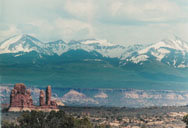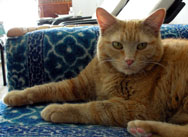First, the main idea of this type of project is to cover ordinary cardboard with pretty paper. Traditionally this is done with organic pastes (rice flour or wheat flour and water) and papers especially designed for the task, called Washi and Yuzen. Think decoupage, but Oriental and therefore classier. The pieces I have seen around the internet have a base paper of some solid color, usually black, with the washi or yuzen "fancy paper" put on in certain places for accent.
So, you first have to start with a cardboard object. You can find boxes and such at a craft store like Michael's. I prefer to make my own cardboard objects. My first washi project was a small three-drawered jewelry box, and this bill-holder is my second project. (You can also find really simple pre-fab projects with self-adhesive paper and cardboard and instructions included. Normally you would have your whole object put together first (cardboard held together by masking tape, not glued) and then cover the object as a whole with the black paper. This means you have to really plan out the shape of this one big piece of paper, where all the notches are, how things get folded over, etc.
Supplies:
cardboard
paper
paste
sponge
newspaper
large flat heavy things for flattening
exacto knife
pencil
ruler
masking tape
Cardboard for your object: With smaller projects if you keep the cardboard that comes with your origami paper you can use that. With some packs of paper I got cardboard that was upwards of 1/8" thick. The size of this project though, forced me to go looking for cardboard whole-salers. No luck for 1/8", but I did find watercolor matte at Michael's that comes 2' x 3', and is 1/16” thick. I first cut out all the pieces I needed and then glued together the ones I wanted to be 1/8” thick
What paper to use: If your object is small enough, the large size origami paper works well for the base black paper. Once everything is pasted down, it is very difficult to see seams or overlaps of paper. Even if you can't see the overlaps, I still like cover as much (all) surface area as possible with one piece of paper. So, my bill-holder was too big for the large origami paper, so I found a roll of black paper at Michael's. I'm not sure what it's for, maybe scrapbooking or something. It's rather thick, and I would say it's the thickest paper you'd ever want to use in washi projects. (paper softens up with the paste, but this stuff almost not enough). Whatever paper you find, make sure it isn't too waxy, like the generic origami paper. This stuff still soaks up the paste eventually, but once you see how washi or yuzen paper reacts to the paste you'll understand. Once you have the base paper selected, you have to find a fancy paper. Again, if you project is small enough, you can find origami paper (the good kind, not generic) that will fit your accent spaces. If not, like this bill-holder, you have find paper in 3' x 4' sheets. Find a pattern and color you find pleasing. This is why I find the black base paper the most attractive. You don't have to worry about clashing colors between the base and the fancy papers. The black paper recedes into the background and makes the fancy paper the focus.
Paste: I hear you can buy the right kind of paste already made up, but making it is so easy that I don't bother. I use wheat flour, like the kind for baking. 1:7 ratio of flour:water. I do this is teaspoons and it makes a good volume to work with. Cook this on the stove on low heat with constant stirring. After a while (depends on how fast your stove is) you'll see the mixture go from the flour simply suspended in the water to actually a homogenous solution. It'll get thicker, has a translucent look to it, and I usually let it go until it has boiled for maybe a minute. Then I take it off the heat, let it cool some, and decide if the consistency is right. I usually end up throwing in one more teaspoon of water at this point to thin it down just a touch. For consistency keep this in mind: if there is too much flour in the paste, it will not give a transparent finish, especially against black paper. If there is too little flour in the paste, it won't act like a paste!
**The paste does go bad! You can keep it in the fridge, but it probably won't last even a week that way. It's easy to make, so no big deal.**
Sponge, newspaper: Sponge for applying the paste and wiping off excess and giving a wipe down after the paper is applied (working out air bubbles, etc.). Newspaper for soaking up the moisture. You can lay your paper to be pasted out on the newspaper, apply the paste while going over the edges and not have to worry about it.
Large flat heavy things: I happened to have 1’ x 1’ marble tile in the garage and boxes of ammo for weight, This combination worked excellently to flatten pieces as they dried. (another use for the newspaper here: to soak up moisture in the flattening process.)
Exacto knife: A sharp blade cuts the watercolor matte fairly well. I did two slices along the ruler as a straight-edge, then the track was deep enough to not need the straight-edge anymore
Pencil: Regular one for the fancy paper (it’s white on the back), but had to use the white chalk pencil (for sewing) on the black paper.
Ruler: Any straight edge with markings, and also a triangle or T-square to get right-angles.
Masking tape: This works well for putting the cardboard together. I had a roll that was 2” wide and very thin tape. So thin that is was hard to tear off the roll.
To be continued...
Sunday, April 15, 2007
Subscribe to:
Post Comments (Atom)







No comments:
Post a Comment